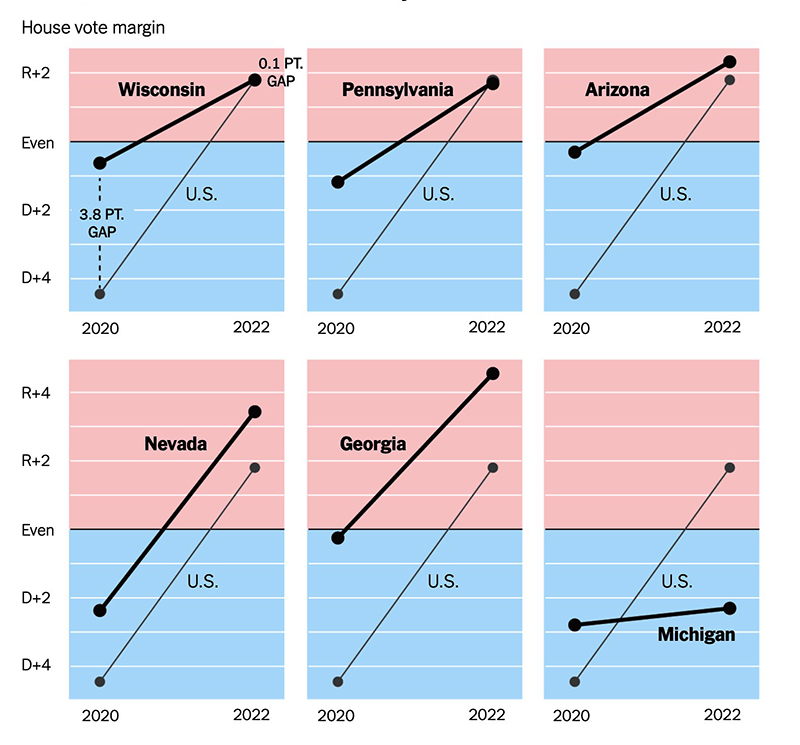

We looked at this briefly last week, but it's worth a closer examination. It has been an article of faith for a number of years that the Electoral College favors the Republicans due to all the small, thinly populated red states. A new analysis by the other Nate (Cohn) suggests that changes in key states may be the most important factor in 2024.
In Donald Trump's two presidential campaigns, he did better in key swing states than he did in the country as a whole. This observation has prompted numerous pundits to say that Democrats must win the national vote by at least 4 points in order to offset the built-in bias. That may not be true anymore. A comparison of the House vote in 2020 and 2022 in six swing states shows that the Republicans advantage there has disappeared in four of them. Here are graphs:

For example, the total Republican House vote in Wisconsin in 2020 was 3.8 points more favorable to the Republicans than the national vote that year. In 2022, the gap between Republicans and Democrats was about the same in Wisconsin as nationally. In other words, Democrats didn't underperform the national average in Wisconsin in 2022. They tracked it closely. That is also true of Pennsylvania and Arizona. In Nevada and Georgia, not much changed, but in Michigan Democrats underperformed compared to the national average in 2020 but greatly overperformed in 2022 (including winning the trifecta).
Can we conclude anything from these data? Well, every election is different, but the trend in at least four swing states seems to be moving in the right direction for the Democrats. They no longer have to have at least a 4-point edge nationally in order to win states important in the Electoral College like Wisconsin, Pennsylvania, and Arizona.
Cohn also presents data about swing-state polling. Over the past year, Biden led Trump in the national polls by about 1.3 points. In the past, that wouldn't have been enough to win the swing states, yet he has small leads in Wisconsin, Pennsylvania, and Michigan. Does that say a lot? No, but it agrees with the graphics above. Biden may not have to win the national vote by 4 points to win the swing states as they are tracking the national results more closely now.
Recent changes in the voting behavior of different demographic groups is also relevant here. Biden has been gaining slightly among all white voters while Trump has been gaining slightly among nonwhite voters. But Wisconsin, Michigan, and Pennsylvania were at least 83% white in the 2020 election, compared to 69% nationally. A slight gain among white voters and a slight loss among nonwhite voters will help Biden in the these three battleground states, even if it makes his wins in California and New York smaller. However, it could cost him Arizona, a heavily Latino state. On the other hand, Democrats won a Senate seat, the governorship, the attorney general position and the secretary of state in Arizona in 2022, so the general leftward trend of the state may outweigh losses among minority voters. (V)